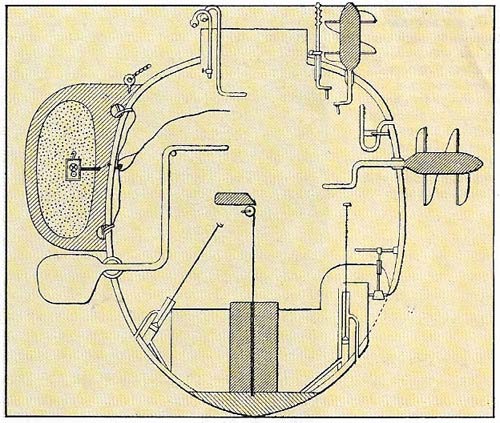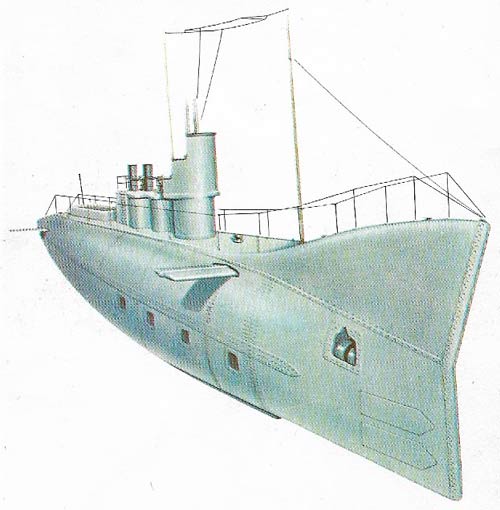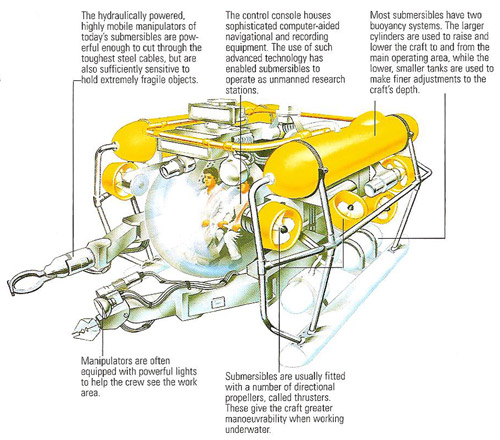submarine

Figure 1. The Turtle, an American submarine, was in 1776 the first to operate in a war. The single crewmember worked all the controls – lateral and vertical propellers, rudder, and pumps – by hand. The packet of explosives (left) was detachable and designed to be fixed to the hull of an enemy vessel.

Figure 2. The largest submarine of World War I was the K-class of the British Royal Navy. It was 103 m (338 ft) long and had a crew of 55. The war proved that submarines were not greatly effective against warships but could be used to sink merchant ships and disrupt supply lines. Germany had no ocean supply lines but the Allies lost 32 ships for every German submarine they succeeded in sinking.

Figure 3. The German U-boat (Unterseeboat) was responsible for sinking millions of tons of Allied shipping during the early stages of World War II. Working in packs and armed with fore and aft torpedo tubes, the U-boats stalked convoys by day and attacked by night. The Allied development of radio direction finding and radar made surfaced submarines vulnerable to aircraft attack.

Figure 4. The Johnson Sea Link, a diver lockout submersible, which is equipped with pressure chambers from which divers can enter and exit, allowing them to perform work and then return to the submersible for gradual decompression.
A submarine is a ship capable of underwater operation. The invention of the submarine is usually credited to an Englishman, William Bourne. In 1578 he described a vessel that could take on and expel water to vary its buoyancy and that used a snorkel-like tube for its air supply. There is no evidence that Bourne's craft ever sailed and the first submarine was probably a wooden-framed vessel, like a rowing boat, covered with greased leather, built by a Dutch engineer Cornelius van Drebbel (1572–1634) in about 1620. According to the British chemist Robert Boyle such a boat took King James I for a ride beneath the River Thames and even had some kind of "liquor" for renewing the air inside. Unfortunately no drawings or detail of this craft have survived.
Submarines in wartime
The Turtle (Figure 1), a one-man submarine invented in 1776 by an American, David Bushnell (c. 1742–1824), was the first underwater vessel to be used in war. It pioneered two essential features of the modern submarine: a closed hull and screw propulsion, although the latter was worked by hand. But two further developments were necessary before the submarine could become an effective fighting machine: a good undersea weapon and a source of power. The Confederate navy used submarines during the American Civil War. Small craft known as Davids – named after the biblical David who vanquished the giant Goliath – were each armed with an explosive charge at the end of a long spar and powered by hand or steam. In 1864, a David, the Hunley, rammed the Union ship Housatonic off Charleston harbor; both vessels sank and the crew of the Hunley were killed. A self-propelled torpedo was also invented.
Propulsion, the major problem, was partly solved
by the Rev. G. W. Garrett, who built a steam-powered submarine (1880). By the turn of the century the American inventor John P. Holland (1840–1914) and his rival Simon Lake were designing submarines powered by gasoline engines on the surface and electric motors when submerged. These vessels, armed with torpedoes and guns, were the forerunners of modern submarines and contained all the basic features of those that fought in both world wars. German submarines (U-boats) during World War I were highly effective as raiders of unarmed merchant ships, thereby threatening to cut Britain's vital supply lines. In World War II submarines took a toll of warships as well [6].
The effectiveness of the submarine remained limited by the slowness and short duration of undersea travel when vessels depended on electric motors powered by batteries. The batteries soon became exhausted and submarines had to surface frequently to obtain air for the diesel engines and recharge the batteries (through a dynamo driven by the engines). The diesel engines were also used for surface propulsion. In World War II, German U-boats were equipped with a snorkel tube to supply air to the diesel engines, which could be run just below the surface. This helped the submarine to escape detection.
But none of these vessels could remain submerged for very long, and true (long-term) submarines awaited the advent of nuclear power. The first nuclear-powered submarines was USS Nautilus (1955), which in 1958 made the first voyage under the polar icecap. The US, Russia, UK, and France have nuclear submarine fleets equipped fitted with ballistic missiles.
How submarines work
Modern submarines are streamlined vessels, generally with a double hull, the inner being a pressure hull with fuel and ballast tanks between it and the outer hull. The submarine submerges by flooding its ballast tanks to reach neutral buoyancy, i.e., displacing its own weight of water (see Archimedes' principle), and dives using its hydrofoil diving planes. Buoyancy is restored by expelling the water from the ballast tanks with compressed air.
The central structure – the conning tower or sail – contains a periscope, radio and radar aerials, and a snorkel tube. Tracking of an enemy vessel is accomplished by sonar (underwater) and radar (when surfaced) and communications are by radio. Navigation is by a computerized inertial guidance system, assisted by sonar and radar in coastal waters or beneath ice floes. The periscope is used for photographing and for checking navigation by sextant.
The nuclear submarine is a true undersea craft. It needs no air for its motors and can make long undersea voyages without refuelling. The first of these vessels, the USS Nautilus, was also the world's first nuclear-powered warship of any kind. Launched in 1954, its capabilities drastically changed the military strategy of the Great Powers. Instead of raiding surface vessels, nuclear submarines carry long-range intercontinental missiles armed with nuclear warheads that can be launched underwater. The submarines constitute a strike force that is practically invulnerable because they cannot easily be located when submerged. They are intended to respond to the first strike against a country and thus deter any nation from making such an attack. In addition to intercontinental missiles the submarine can carry torpedoes that either home acoustically or are guided by a wire trailed behind the torpedo. Weapons that are part-torpedo and part-missile can also be carried for use against distant vessels.
Submersibles
A submersible is a small craft for underwater exploration, research, or engineering. Modern submersibles have evolved from simple devices. Diving bells were open-bottomed devices in which people were lowered into the water. A device called the bathysphere, invented in the 1930s by William Beebe, was a spherical observation chamber. The bathyscaphe, invented in the 1940s by August Piccard, also had a spherical chamber, but this was attached to a much larger hull, which was used as a buoyancy control device. The craft also had propellers powered by electric motors.
A new generation of submersibles has emerged since the late 1950s for engineering and research work. A typical craft has a spherical passenger capsule capable of withstanding water pressure down to about 3,600 meters (12,000 feet). Attached to this is a structure containing batteries, an electric motor with propeller, lighting, a mechanical arm for gathering samples, and other technical equipment. A specially designed support ship launches and retrieves the submersible, Some submersibles are unmanned and operated by remote control from the surface.
Nuclear submarine
A nuclear submarine is an underwater vessel powered by a nuclear reactor. The great advantage of nuclear submarines is that they use little fuel and may remain submerged for many weeks, even months. Heat produced by the reactor turns water into steam. The steam turns turbines, which are linked to electricity generators that charge the submarine's batteries. The vessel's propeller may be driven by an electric motor, or by linking its shaft to a turbine. The first nuclear submarine, the USS Nautilus, was launched by the US Navy in 1954. Nautilus travelled 100,000 kilometers (62,000 miles) in its first two years of service, and in 1958 was the first vessel to sail under the ice cap at the North Pole. Britain's first nuclear submarine was HMS Dreadnaught (launched 1963). Nuclear submarines carrying missiles have enormous firepower and are difficult to detect and destroy.


